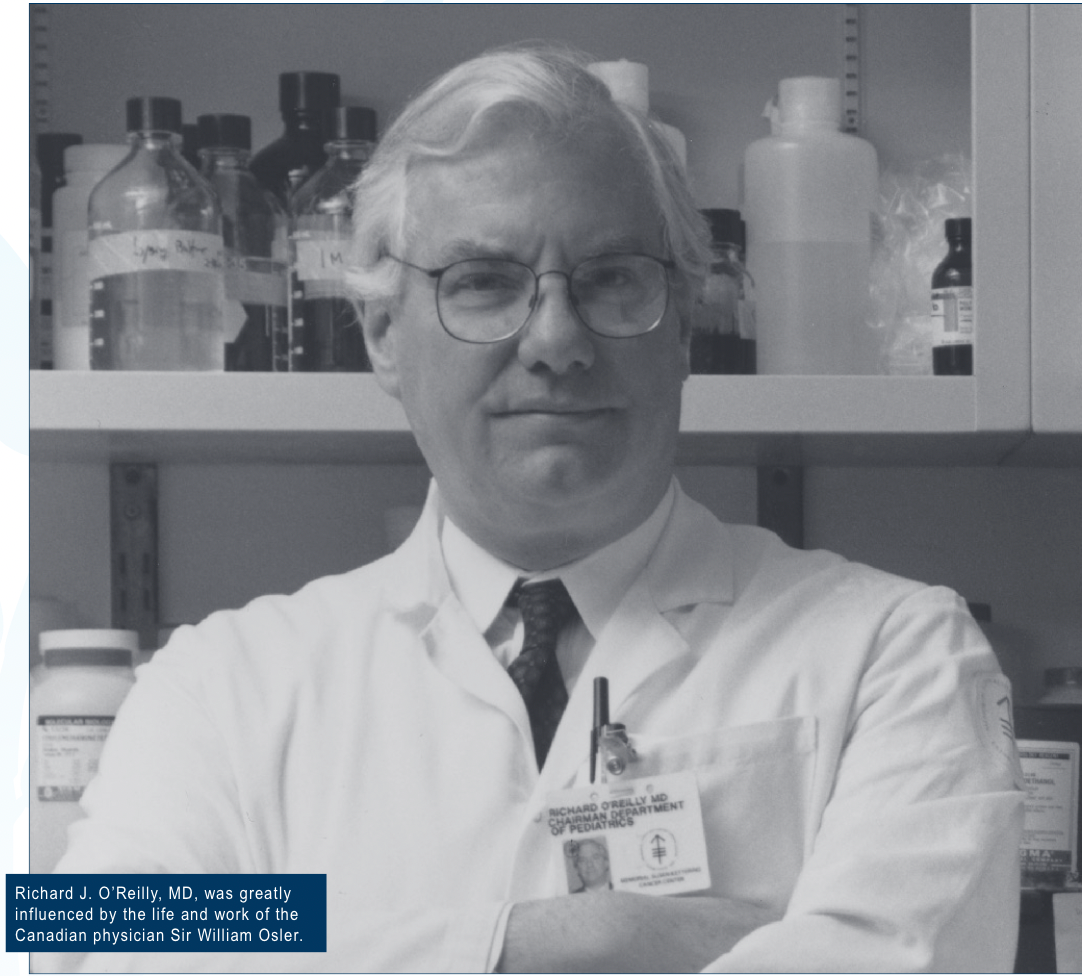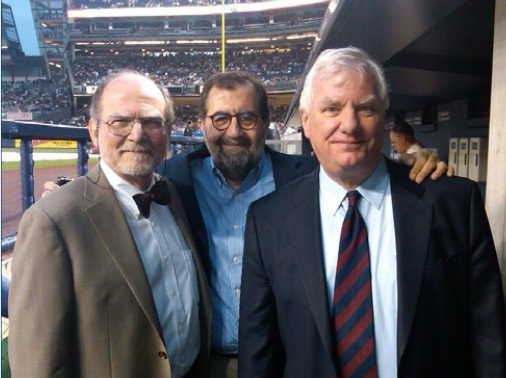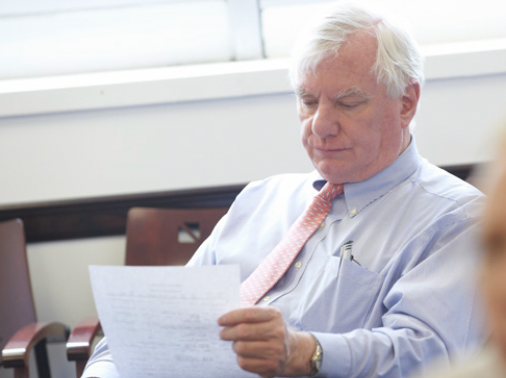Article
Transplants Are in His Blood: Richard J. O'Reilly Is a Giant of Cancer Care in Pediatric Cancer
Author(s):
“I can’t conceive of anything worse than being in a situation where you can’t ask, ‘How do we get better?’ ”
Richard J. O’Reilly, MD

Something changed for Richard J. O’Reilly, MD, then a premed student at the College of the Holy Cross in Worcester, Massachusetts, when he listened to guest speaker and alumnus Joseph E. Murray, MD, give a lecture to his class.
Murray—a surgeon who would later receive the 1990 Nobel Prize in Physiology or Medicine for conducting the first successful human renal transplantation—was a pleasant surprise for O’Reilly. This was his first readout on transplants, and it stuck with him.
“At the time, I wasn’t even thinking about that type of career,” O’Reilly recalled. “But in the long run, some of the words he said still hit me on a regular basis, day to day.”
Murray offered a refreshing perspective on patient rights. He was adamant about the responsibility of medical practitioners to listen to patients’ wants and needs throughout the decision-making process. This fierce advocacy impressed the future physician.
O’Reilly found the philosophy courses he took at Holy Cross to be worthwhile because the curriculum placed an emphasis on developing a “personal philosophy.” Until this lecture, however, he had not thought much about just how relevant, let alone pivotal, these philosophy courses could be for premed students like him.
But Murray, who concentrated on philosophy while an undergrad, helped him connect those dots. To O’Reilly, the older man embodied the idea of implementing a personal philosophy while practicing medicine.
If O’Reilly thinks even further back, to his time at Xavier High School in New York, New York, he recalls a family friend giving him a copy of “The Life of Sir William Osler,” a biography by written by the pioneering neurosurgeon Harvey Cushing, MD. The friend told him the book explained what a life in medicine meant.
Richard J. O’Reilly, MD, was greatly influenced by the life and work of the Canadian physician Sir William Osler.

O’Reilly learned that Osler introduced approaches to diagnosis based on detection of clinical features that distinguished one disease from others that were similar and implemented the system of residency training for physicians, introducing a humanistic approach to the then-strictly scientific realm of medicine. Osler, who helped establish Johns Hopkins Hospital, is still widely regarded as one of the most influential physicians of the late 19th and early 20th century, and his impact on O’Reilly was just as meaningful.
“He was a good listener and quite an extraordinary observer,” O’Reilly said about Osler. “I thought that he would be a neat model to follow.”
Alongside Murray and Osler, O’Reilly’s grandfather, a professor of medicine at what is now SUNY Downstate Medical School in Brooklyn, New York, was a major influence on the future physician.
“I never knew him at all,” O’Reilly said about his grandfather. “But the idea of being a doctor was something that I thought about as a child because people said that my grandfather had been a good doctor. I thought that was a wonderful thing.”
Establishing His Path
With a career as a clinical investigator in the back of his mind thanks to Murray’s lecture, O’Reilly went from Holy Cross to medical school at the University of Rochester. There, he first developed an interest in immunology and had the good fortune to work on a research project under John Vaughan, MD, studying antibody molecules.
During that time, he cared for a child who ultimately died of leukemia.
“This child’s parents were an extraordinary twosome the way they took care of their daughter,” O’Reilly said. “They were wonderful people, the human beings whom [pediatric oncologists were] lucky to serve on a daily basis. That was a big mover for me at the time.”
And from this experience came a decision to specialize in pediatrics. O’Reilly went on to take an internship in pediatrics at the University of Minnesota (UMN) in Minneapolis. There, he had the opportunity to work with Robert A. Good, MD, PhD, a physician and researcher who identified the essential role of the thymus for the development of one part of a 2-component system of immunity and who is today considered one of the founders of modern immunology.
“I met him, and he became an extraordinary mentor,” O’Reilly said. “I took care of as many kids with immune deficiencies as I could and learned as much about his 2-component system as I could.”
O’Reilly visits the New York Yankees’ dugout with MSK colleagues Paul A. Meyers, MD, left, and Farid Boulad, MD.

In 1968, O’Reilly, as an intern, observed Good and his team at UMN perform the first successful bone marrow transplant between a patient and a donor who were not identical twins. They corrected a lethal genetic immune deficiency in a 5-month-old boy using bone marrow extracted and infused from the boy’s 8-year-old sister following white cell–type matching.
“He still runs around Connecticut and is doing perfectly fine,” O’Reilly said about the former patient, now an adult. “The only thing that’s unusual about him is that all of his blood cells are female because they’re all derived from his sister. And so, transplants were, at that point, in my blood.”
Throughout his 4 decades and counting in medicine, O’Reilly has been a pioneer in transplantation for leukemia and other life-threatening diseases of blood cells and immunity. His work has dramatically expanded transplant options, increased survival rates, and improved quality of life for pediatric patients and adults. His innovative techniques are now in practice worldwide and have significantly changed the way we treat children with these diseases.
He also developed new immune cell therapies to manage other potential complications of transplantation, such as Epstein-Barr virus–associated lymphomas and cytomegalovirus infections.
Among his many groundbreaking accomplishments, O’Reilly and his colleagues developed and introduced methods for removing T cells from a donor’s transplant, allowing use of transplants from HLA half-matched donors without the risk of graft-vs-host disease.
During his career, O’Reilly has contributed to research that turned pediatric leukemia from a near death sentence to a disease with a cure rate greater than 90%.

"That was a big change because all of a sudden, you could prevent the immune cells in the transplant from reacting against the patient, a disease called graft-vs-host disease,” O’Reilly said. “What I felt good about was that these T-cell–depleted transplants were able to prevent that potentially lethal disease on a regular basis.
Then we used that type of transplant for the treatment of patients, both kids and adults, who had leukemia.”
O’Reilly said he has done more than 1000 of these transplants with this approach since its initial development.
His Legacy at MSK
Beginning in 1986, O’Reilly served as the chair of the Department of Pediatrics at Memorial Sloan Kettering Cancer Center (MSK). He was also chief of marrow transplantation in pediatrics and medicine, where he started the clinical and preclinical research programs on transplantation medicine and immunology. His work helped establish MSK’s worldwide reputation for bone marrow transplantations in children with severe combined immune deficiencies and leukemia.
During his more than 4 decades in medicine, O’Reilly has performed more than 1000 T-cell–depleted bone marrow transplants

O’Reilly is amazed when he reflects on how much has changed at the cancer center in his 35 years there. When he started, there was a lot of excitement about the initial results of intensive combination chemotherapies that “had a real effect.” Now these regimens, in some instances coupled with immunotherapies, are resulting in ever-increasing numbers of sustained complete remissions and cures.
“One has to think about the fact that when I was a resident, I was told that it was unethical for people to tell a parent that their child was going to survive leukemia. Unethical,” O’Reilly recalled. “Now we’re talking about 90% of kids with the most common type of acute leukemia, acute lymphoblastic leukemia, who can achieve durable remissions and cures. These changes...occurred initially through development of intensive combinations of chemotherapeutic agents coupled with the development of exceptionally effective methods for supportive care that have sustained kids extremely well.”
Now, with tumor-targeted drugs and immunotherapies, physicians can prescribe less-toxic regimens that may achieve the same curative result. A good example is imatinib (Gleevec), a relatively nontoxic agent that targets the genetic alteration that causes chronic myelogenous leukemia (CML). Before imatinib, and agents like it, a marrow transplant was the only curative treatment for CML.
O’Reilly said he feels lucky enough to work at an exceptional place where physicians and scientists are encouraged to develop new, potentially better ways to detect and treat cancer.
“This center is unique in terms of the fact that it is pledged to an extraordinary science,” he said. “But also, it has an ongoing commitment to the translation of that science into something meaningful for patients. It is striking in that regard because that commitment is on a day-to-day basis.”
When asked why he has dedicated so much of his career toward clinical research, O’Reilly couldn’t think of a reason why he wouldn’t.
“When you’re in the field of cancer, particularly when you’re dealing with kids with cancer, I can’t conceive of anything worse than being in a situation where you can’t ask, ‘How do we get better?’” O’Reilly said. “The key is that progress doesn’t come from doing the same thing and failing over and over again. It comes from constantly asking questions about the disease, the patient, and the treatment that might contribute to failures and developing new ways to address them. That’s why the research component has been so key because if you can define a problem and if you can then conceive questions and test hypotheses [that] would potentially address the problem, then it makes work very fulfilling.”
Quotes To Live By
O’Reilly still recalls the sign that hung on the office door of his fellowship mentor, Porter W. Anderson Jr, PhD—a microbiologist who developed the vaccine to prevent Haemophilus influenzae meningitis—while O’Reilly did his fellowship training at Boston Children’s Hospital. It read,
“Beware of the things you are surest about because they get you in the most trouble.” That message, originally found on a Tetley tea bag, still resonates with him. “It is actually the case that so many of the absolute dogmas out there are only concepts, so you just have to think about them more,” he explained.
The other quote is from poet Robert Frost’s “The Road Not Taken,” which famously goes, “Two roads diverged in a wood and I—/I took the one less traveled by,/And that has made all the difference.”
“Well, it’s true,” O’Reilly said. “In medicine, what’s extraordinary about it, and particularly so in oncology, is that you’re in a circumstance where you’re facing that ‘two roads diverged in a yellow wood,’ oftentimes on a daily basis. You make conscious decisions. The key point in medicine is if you pursue [the road less traveled], almost always, you’re going to find something interesting and worthwhile.”
When asked what legacy he hopes to leave for the next generation of pediatric oncologists, O’Reilly naturally responded with an inspirational quote: “Dare to dream,” he said.
He quickly added, “Never be satisfied.”
















%20(2)%201-Recovered-Recovered-Recovered-Recovered-Recovered-Recovered-Recovered-Recovered-Recovered-Recovered-Recovered-Recovered-Recovered-Recovered-Recovered-Recovered-Recovered.jpg?fit=crop&auto=format)
%20(2)%201-Recovered-Recovered-Recovered-Recovered-Recovered-Recovered-Recovered-Recovered-Recovered-Recovered-Recovered-Recovered-Recovered-Recovered-Recovered-Recovered-Recovered.jpg?fit=crop&auto=format)
